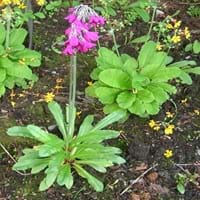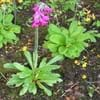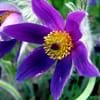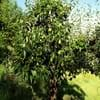Life Span
Perennial
Perennial
Origin
Hybrid origin
Hybrid origin, Mexico, Central America, South America
Types
Not available
Not Available
Habitat
Damp forests, Woodland Garden
Coastal Regions
USDA Hardiness Zone
3-8
11-15
Sunset Zone
Not Available
A1, A2, A3, H1, H2, 1a, 1b, 2a, 2b, 3a, 3b, 4, 5, 6, 7, 8, 9, 10, 11, 12, 13, 14, 15, 16, 17, 18, 19, 20, 21, 22, 23, 24
Habit
Rosette/Stemless
Upright/Erect
Minimum Height
Not Available
Minimum Width
Not Available
Flower Color
Yellow, Red, Purple, Orange
Yellow
Flower Color Modifier
Not Available
Bicolor
Fruit Color
Not Applicable
Red
Leaf Color in Spring
Green
Green, Dark Green
Leaf Color in Summer
Green
Green, Dark Green
Leaf Color in Fall
Green
Green, Dark Green
Leaf Color in Winter
Light Green
Green, Dark Green
Leaf Shape
Oblong elliptic
Ovate
Plant Season
Summer, Fall
Spring, Summer, Fall
Sunlight
Full Sun, Partial Sun, Partial shade
Full Sun
Type of Soil
Loam
Loam, Sand
The pH of Soil
Neutral
Neutral
Soil Drainage
Average
Well drained
Bloom Time
Summer, Late Summer, Early Fall, Fall
Indeterminate
Tolerances
Drought
Drought
Where to Plant?
Ground, Pot
Container, Ground
How to Plant?
Divison, Seedlings
Grafting, Seedlings
Plant Maintenance
Medium
Medium
Watering Requirements
Do not let dry out between waterings, Keep ground moist, Keep the Soil well drained, Requires regular watering
Needs more water during establishment
In Summer
Lots of watering
Lots of watering
In Spring
Moderate
Moderate
In Winter
Average Water
Average Water
Soil Type
Loam
Loam, Sand
Soil Drainage Capacity
Average
Well drained
Sun Exposure
Full Sun, Partial Sun, Partial shade
Full Sun
Pruning
Remove damaged leaves, Remove dead branches, Remove dead leaves
Pinch or prune as they grow to promote branching and bushiness
Fertilizers
All-Purpose Liquid Fertilizer
14-14-14 Fertilizer, Compost
Pests and Diseases
Dry root rot, Leaf spot
Anthracnose, Aphids, Red blotch, Rust
Plant Tolerance
Drought
Heat Tolerance, Salt and Soil Compaction
Flower Petal Number
Single
Single
Fragrant Bark/Stem
No
Yes
Showy Bark
Insignificant
No
Foliage Texture
Coarse
Medium
Foliage Sheen
Matte
Matte
Attracts
Insects
Aphids, Not Available, Squirrels
Allergy
Not Available
Stomach pain, Vomiting
Aesthetic Uses
Beautification, Borders, Landscape Designing, Showy Purposes
Used in parkland
Beauty Benefits
Not Available
Anti-ageing, Blackheads, Reduce Bruises
Environmental Uses
Air purification, Food for insects, Versatility
Shadow Tree, Soil protection
Medicinal Uses
Not Available
Dehydration, Diabetes, Diarrhea, Nutrients, Weight loss
Part of Plant Used
Flowers, Leaves
Fruits
Other Uses
Decoration Purposes, Medicinal oil, Showy Purposes, Used as Ornamental plant, Used for its medicinal properties
Application in Handicrafts, Food for animals, Showy Purposes
Used As Indoor Plant
Yes
No
Used As Outdoor Plant
Yes
Yes
Garden Design
Edging, Feature Plant, Groundcover, Mixed Border
Edible, Herb, Vegetable
Botanical Name
Primula beesiana
Manilkara zapota
Common Name
Candelabra Primrose, Primrose
sapodilla , chikoo, Sapota
In Hindi
candelabra primrose
चीकू
In German
Kerzenleuchter Primel
Breiapfelbaum
In French
candélabre primevère
Sapotillier
In Spanish
Primula beesiana
chicle
In Greek
μανουάλια primrose
sapodilla
In Portuguese
prímula candelabros
sapodilla
In Polish
kandelabry pierwiosnka
Pigwica właściwa, sapodilla
In Latin
candelabra Primrose
sapodilla
Phylum
Magnoliophyta
Magnoliophyta
Class
Magnoliopsida
Magnoliopsida
Family
Onagraceae
Sapotaceae
Clade
Angiosperms, Eudicots, Rosids
Angiosperms, Asterids, Eudicots
Subfamily
Onagroideae
Sapotoideae
Season and Care of Candelabra Primrose and Sapodilla
Season and care of Candelabra Primrose and Sapodilla is important to know. While considering everything about Candelabra Primrose and Sapodilla Care, growing season is an essential factor. Candelabra Primrose season is Summer and Fall and Sapodilla season is Summer and Fall. The type of soil for Candelabra Primrose is Loam and for Sapodilla is Loam, Sand while the PH of soil for Candelabra Primrose is Neutral and for Sapodilla is Neutral.
Candelabra Primrose and Sapodilla Physical Information
Candelabra Primrose and Sapodilla physical information is very important for comparison. Candelabra Primrose height is Not Available and width Not Available whereas Sapodilla height is 150.00 cm and width 60.00 cm. The color specification of Candelabra Primrose and Sapodilla are as follows:
Candelabra Primrose flower color: Yellow, Red, Purple and Orange
Candelabra Primrose leaf color: Green
Sapodilla flower color: Yellow
- Sapodilla leaf color: Green and Dark Green
Care of Candelabra Primrose and Sapodilla
Care of Candelabra Primrose and Sapodilla include pruning, fertilizers, watering etc. Candelabra Primrose pruning is done Remove damaged leaves, Remove dead branches and Remove dead leaves and Sapodilla pruning is done Pinch or prune as they grow to promote branching and bushiness. In summer Candelabra Primrose needs Lots of watering and in winter, it needs Average Water. Whereas, in summer Sapodilla needs Lots of watering and in winter, it needs Average Water.





